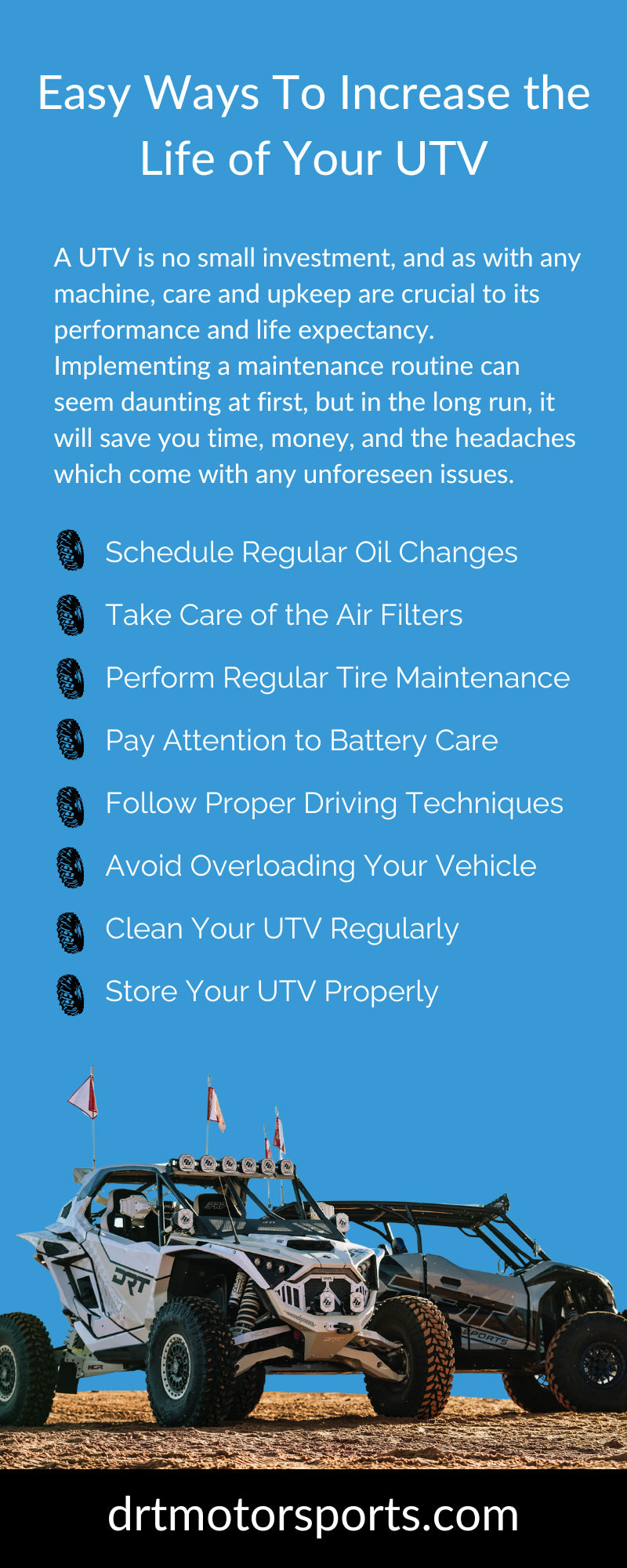Easy Ways to Increase the Life of Your UTV

For those who love off-roading, a UTV is more than just a tool or a toy—it’s a reliable companion through every trail and over any terrain. You could even say that it’s a catalyst for adventure. However, the great outdoors can be unforgiving, and the elements can take their toll if you don’t properly look after your UTV.
To ensure your machine stays in top shape and can handle any expedition, implementing a regular maintenance routine is imperative. This ensures all the parts of your side-by-side (SXS) are functioning optimally, heading off potential issues, and ultimately extending the life of your UTV.
In this comprehensive guide, we’ll walk you through practical and easy ways to increase the life of your UTV. Whether you’re a seasoned owner or just beginning a foray off the beaten path, these maintenance tips will help to preserve your vehicle for years.
The Importance of UTV Maintenance
A UTV is no small investment, and as with any machine, care and upkeep are crucial to its performance and life expectancy. Implementing a maintenance routine can seem daunting at first, but in the long run, it will save you time, money, and the headaches which come with any unforeseen issues.
The frequency and specifics of these tasks vary based on factors like vehicle make, model, and year. Yet, there are general guidelines that all UTV owners can follow to keep their machines operating at peak levels. Read until the end to obtain all the know-how that’s required to preserve any UTV and its components.
Schedule Regular Oil Changes
Regular oil changes for a UTV are like blood transfusions for a sick patient. Fresh, vital fluids in the motor—or the heart of a side-by-side—reinvigorate the internal system. All of which rely on oil to keep the moving parts lubricated and working efficiently.
Over time or with chronic use, oil becomes dirty and loses viscosity, leading to increased wear and tear on those mobile components. Even checking the oil levels before a ride and, if needed, topping it with more fluid will guarantee a polished performance.
The thankless hero in this short story is the filter, which helps to remove contaminants that can accumulate over time from the oil. Make it a habit to change your oil filter every time you do the oil, and you should avoid any unnecessary buildup.
How Often You Should Change the Oil
The cadence at which you should replace motor oil varies. A general rule of thumb, after the break-in period, is around 50 hours of operation or 1,000 miles—whichever comes first. However, this could be smaller interims for older models. Follow the manufacturer’s recommendations for the oil type and change intervals specific to your vehicle.
Take Care of the Air Filters
The air filter is designed to trap contaminants like airborne particles, dirt, and dust and is essential in protecting the engine. A clogged air filter can compromise performance and lead to more significant issues over time. Regular cleaning and, if needed, replacement of filters will extend the engine life and improve fuel efficiency.
How Often to Clean and Replace Air Filters
Ideally, you should inspect the air filter after every ride; then, if necessary, clean it or even pop in a new one. A visual inspection will show you whether it needs cleaning or replacement. If your rides are dusty or muddy, you should err on the side of caution and clean the filters more frequently.
Pro tip: since it can be a bit tedious to wash and lubricate one filter at a time, keep a handful on deck and throw in a new one when the current becomes clogged. Then, once all of them are dirty, put the lot through a full cleaning cycle and restart the rotation.
Perform Regular Tire Maintenance
Tire maintenance is critical for safety (first) and vehicle longevity. Properly inflated tires with good tread depth provide better traction and handling, which can prevent unnecessary strain on the drivetrain. It’s also good practice to check out the integrity and seating of the tires after a rough ride, especially if you aren’t using beadlock wheels.
What To Consider for Tire Maintenance
Inspect the tire pressure before each ride and adjust as needed; the type of terrain also affects the PSI, so research on optimal levels for different ground surfaces would be shrewd. The recommended tire pressure by the manufacturer is a good starting point, but your specific riding conditions might warrant a slight alteration.
Additionally, check the tread for wear and the sidewalls for damage. Making sure the tires are seated properly in the wheel is also good practice. Rotating the tires at regular intervals can also ensure more even wear.
While you’re at it, check the alignment—if not yourself, then with a local SXS garage. This will ensure the rubber wears evenly, preserving your tires’ longevity.
Pay Attention to Battery Care
Unsurprisingly, the battery is a central component powering the electrical systems in your UTV. Neglecting it can lead to starting issues and also increase the load on the charging system, potentially causing damage. When you’re off-roading, you’re distressingly far from civilization. Losing power becomes secondary to being stranded in the middle of nowhere (with no signal).
Essentials of UTV Battery Care
Securely mount the battery and ensure the terminals are clean and corrosion-free. If your UTV tends to sit idle for extended periods, consider using a battery tender to keep the charge steady. If required for the battery type, ongoing observation of the battery’s electrolyte levels is also a good practice.
Follow Proper Driving Techniques
It may not occur to many owners that how a UTV is driven can greatly impact its health. Sudden and extreme acceleration can stress the drivetrain and engine components, increasing the chances of premature wear. Aggressive maneuvers over large obstacles, steep ledges, and G-outs can put undue stress on the suspension, chassis, and exterior.
Some Proper UTV Driving Techniques
Smooth, deliberate application of the gas and brake pedals, as well as steadied appropriate speeds, can significantly reduce the strain on your side-by-side. While the third pedal is uncommon in most UTVs, when using one, avoid “riding” the clutch. When navigating rough terrain, choose your line wisely to minimize the need for sudden movements.
Avoid Overloading Your Vehicle
Every UTV has a payload capacity, and overloading it can cause suspension, steering, and stability issues. Continually stressing these various components may also damage or accelerate wear. Review the stats of your vehicle, which you can usually find in your manufacturer’s manual or on the brand’s website, before packing for your next trip.
The Right Way to Load Your UTV
Always adhere to the recommended payload limits. Distribute the load evenly across the UTV’s bed and avoid hauling more than is necessary. Be especially mindful when carrying heavy loads on inclines or while towing trailers.
Consider that trailers also add to the weight your side-by-side is carrying, so while you might be within your limits in the cab and tow separately, the combined mass could bog down power, straining the motor.
Clean Your UTV Regularly
While regular cleaning keeps your UTV looking spotless (pun intended), it also allows you to catch corrosion and rust. Dirt, rocks, sticks, and other debris can build up in critical components and cause performance issues over time. A good scrubbing now means a pristine ride for you and your loved ones later.
If you can see your SXS clearly, then you can spot early signs of deterioration or damage that might have occurred. Uncovering issues that would otherwise be hidden by muck will prevent further distress. Time like this can be spent thoroughly analyzing your rig, so you don’t have to wait for maintenance day to hunt for issues.
Cleaning Tips for UTVs
Use gentle soap and a sponge to wash your UTV. Avoid high-pressure sprays near sensitive areas, like the electrical bundles or at their connection points, and take a few steps back with your pressure washer if you feel the need to rinse down your engine, although the need with a hooded vehicle is rare.
Store Your UTV Properly
Proper storage can shield your UTV from the elements and potential damage when not in use. A well-maintained storage area can prevent rust and corrosion, protect the tires from the elements, and deter critters from seeking shelter inside your machine. Keeping your beauty behind closed doors also shields it from any curious, prying eyes. Better safe than sorry!
Tips for Proper UTV Storage
Store your UTV in a dry, well-ventilated area, preferably indoors. If outdoor storage is inevitable, use a high-quality cover. Consider raising the vehicle off the ground to prevent flat spots on tires; if not, then periodically roll or drive it to avoid putting weight on only one part of the rubber for too long.
Also, be sure to start the engine to keep components lubricated. Sitting for long periods of time can wear down any machine, so the little actions can make a big difference. While you’re at it, this is an easy opportunity to use a battery tender and cover all your bases.
If you plan to put your SXS away for a while, consider disconnecting the battery altogether. Packing it up for the winter, as they say, doesn’t mean neglecting your UTV until the warmer months. Maintenance is necessary whether or not you’re actively using it.
Regular maintenance might not be the most exhilarating part of owning a UTV, but it’s undoubtedly one of the most important. By following these simple tips for extending the lifespan of your UTV, you can ensure it will remain a reliable and hardworking companion for all your adventures.
To further enhance your UTV riding experience, check out DRT Motorsports’ selection of SXS parts today. The effort you put into maintaining your machine translates directly into the joy and security you experience on the trails. Show your UTV the love it deserves, and it will return the favor with years of trouble-free service.

